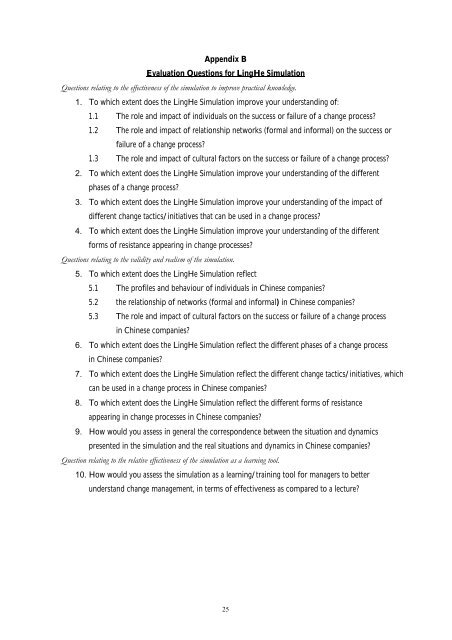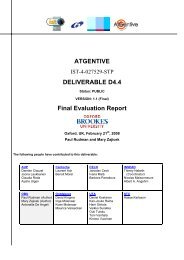LingHe Simulation - INSEAD CALT
LingHe Simulation - INSEAD CALT
LingHe Simulation - INSEAD CALT
Create successful ePaper yourself
Turn your PDF publications into a flip-book with our unique Google optimized e-Paper software.
Appendix B<br />
Evaluation Questions for <strong>LingHe</strong> <strong>Simulation</strong><br />
Questions relating to the effectiveness of the simulation to improve practical knowledge.<br />
1. To which extent does the <strong>LingHe</strong> <strong>Simulation</strong> improve your understanding of:<br />
1.1 The role and impact of individuals on the success or failure of a change process?<br />
1.2 The role and impact of relationship networks (formal and informal) on the success or<br />
failure of a change process?<br />
1.3 The role and impact of cultural factors on the success or failure of a change process?<br />
2. To which extent does the <strong>LingHe</strong> <strong>Simulation</strong> improve your understanding of the different<br />
phases of a change process?<br />
3. To which extent does the <strong>LingHe</strong> <strong>Simulation</strong> improve your understanding of the impact of<br />
different change tactics/initiatives that can be used in a change process?<br />
4. To which extent does the <strong>LingHe</strong> <strong>Simulation</strong> improve your understanding of the different<br />
forms of resistance appearing in change processes?<br />
Questions relating to the validity and realism of the simulation.<br />
5. To which extent does the <strong>LingHe</strong> <strong>Simulation</strong> reflect<br />
5.1 The profiles and behaviour of individuals in Chinese companies?<br />
5.2 the relationship of networks (formal and informal) in Chinese companies?<br />
5.3 The role and impact of cultural factors on the success or failure of a change process<br />
in Chinese companies?<br />
6. To which extent does the <strong>LingHe</strong> <strong>Simulation</strong> reflect the different phases of a change process<br />
in Chinese companies?<br />
7. To which extent does the <strong>LingHe</strong> <strong>Simulation</strong> reflect the different change tactics/initiatives, which<br />
can be used in a change process in Chinese companies?<br />
8. To which extent does the <strong>LingHe</strong> <strong>Simulation</strong> reflect the different forms of resistance<br />
appearing in change processes in Chinese companies?<br />
9. How would you assess in general the correspondence between the situation and dynamics<br />
presented in the simulation and the real situations and dynamics in Chinese companies?<br />
Question relating to the relative effectiveness of the simulation as a learning tool.<br />
10. How would you assess the simulation as a learning/training tool for managers to better<br />
understand change management, in terms of effectiveness as compared to a lecture?<br />
25
















